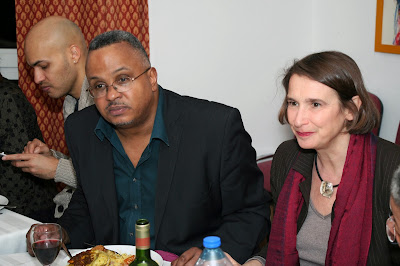Author and activist Ishmael Reed recently spent a few days in Paris with his family before heading to eastern France to participate in the international colloquium “American Multiculturalism in Context”. Organized by l’Institut de Recherche en Langues et Littératures Européennes (European Languages and Literatures Research Institute) at the Université de Haute-Alsace in Mulhouse, the conference seeks to “reassess American multiculturalism from today’s perspective, look back at its history, its development, [its] success[es] and finally [its] celebration as politically correct dogma.”
Ishmael Reed
© Discover Paris!
The organizing committee selected Reed as its special guest because he is an expert on the development of art and journalism within the context of the American multicultural experience and because,
As a songwriter, Reed has collaborated for years on musical works with jazz saxophonist and Paris resident David Murray. One of their most recent collaborations is the 2013 CD Be My Monster Love, with three new songs with lyrics by Reed: “Army of the Faithful,” "Hope is a Thing With Feathers," and the title track, "Be My Monster Love."
Be My Monster Love by David Murray
CD cover
For this special occasion, Murray’s wife, Valerie Malot, organized a dinner reception for Reed at their Ménilmontant home. Malot is the executive director and founder of 3DFamily, an agency that produces concerts and books international tours for performing artists.
Murray was unable to attend the event due to a prior commitment to perform at a Tunisian jazz festival, which he honored despite the recent terrorist attack at the Bardo Museum in Tunis. Among the invitees were novelist and playwright Jake Lamar, fashion model Chrystèle Saint-Louis Augustin, former senior vice president of marketing and communications for the US Fund for UNICEF Veronica Pollard, special advisor to the president of the National Committee for the Remembrance and History of Slavery Florence Alexis, and author and book critic Thomas Chatterton Williams.
Ishmael Reed regales guests with an anecdote
© Discover Paris!
Chrystèle Saint-Louis Augustin and Mahamadou Lamine Sagna
© Discover Paris!
Veronica Pollard and Florence Alexis
© Discover Paris!
Thomas Chatterton Williams
© Discover Paris!
Invited to a reception that was to last from 6-8 PM, guests were pleasantly surprised to find tables set for dinner and were regaled by an Algerian feast consisting of a cooked tomato and red pepper entrée and a main dish of couscous served with chicken and meatballs, followed by oriental pastries and fresh mint tea.
Jake and Dorli Lamar at table
© Discover Paris!
Feasting on couscous
© Discover Paris!
A good time was had by all!
************
If you like this posting, share it with your friends by using one of the social media links below!
© Discover Paris!
The organizing committee selected Reed as its special guest because he is an expert on the development of art and journalism within the context of the American multicultural experience and because,
As a prolific writer and opinionator, he has been in the eye of the storm ever since he first promoted the American “multicultural artist” in the late 1960s.
As a songwriter, Reed has collaborated for years on musical works with jazz saxophonist and Paris resident David Murray. One of their most recent collaborations is the 2013 CD Be My Monster Love, with three new songs with lyrics by Reed: “Army of the Faithful,” "Hope is a Thing With Feathers," and the title track, "Be My Monster Love."
CD cover
For this special occasion, Murray’s wife, Valerie Malot, organized a dinner reception for Reed at their Ménilmontant home. Malot is the executive director and founder of 3DFamily, an agency that produces concerts and books international tours for performing artists.
Murray was unable to attend the event due to a prior commitment to perform at a Tunisian jazz festival, which he honored despite the recent terrorist attack at the Bardo Museum in Tunis. Among the invitees were novelist and playwright Jake Lamar, fashion model Chrystèle Saint-Louis Augustin, former senior vice president of marketing and communications for the US Fund for UNICEF Veronica Pollard, special advisor to the president of the National Committee for the Remembrance and History of Slavery Florence Alexis, and author and book critic Thomas Chatterton Williams.
© Discover Paris!
© Discover Paris!
© Discover Paris!
© Discover Paris!
Invited to a reception that was to last from 6-8 PM, guests were pleasantly surprised to find tables set for dinner and were regaled by an Algerian feast consisting of a cooked tomato and red pepper entrée and a main dish of couscous served with chicken and meatballs, followed by oriental pastries and fresh mint tea.
© Discover Paris!
© Discover Paris!
A good time was had by all!
Entrée to Black Paris!™ is a Discover Paris! blog.
If you like this posting, share it with your friends by using one of the social media links below!

















%2Band%2Bothers.jpg)








